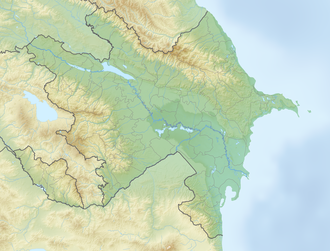Aza Bridge
Aza bridge Aza körpüsü | |
|---|---|
| Coordinates | 38°55′45″N 45°49′21″E / 38.929104°N 45.822445°E |
| Crosses | Gilanchai river |
| Characteristics | |
| Material | Stone |
| Total length | 46 meters |
| Width | 3.5 meters |
| History | |
| Construction end | XVII century |
| Rebuilt | 1997 |
| Location | |
 | |
Aza Bridge — a historical architectural monument located in the village of Azadkend in the Ordubad District of Azerbaijan, built during the Safavid period.
The bridge was included in the list of architectural monuments of national importance by Decision No. 132 of the Cabinet of Ministers of the Republic of Azerbaijan dated August 2, 2001, and Decision No. 98 of the Cabinet of Ministers of the Nakhchivan Autonomous Republic dated November 21, 2007.
History
[edit]Aza Bridge was built in the 17th century over the Gilanchay River in the village of Azadkend, Ordubad District.[1][2]Connecting the villages of Azadkend and Darkend, the bridge is 3.5 meters wide and 46 pogonometric meters long.[3][2]It has five spans and is constructed from reddish hewn local mountain stone.[2][1] During its construction, the terrain was taken into account, and the distances between the arches were made in varying sizes.[3] Four of the arches are equipped with wave breakers.[1][4] The bridge was built during the reign of the Safavid ruler Shah Abbas I to facilitate the movement of trade caravans traveling along the Silk Road from east to west and vice versa.[1][5][6]
After Azerbaijan regained its independence, the bridge was included in the list of immovable historical and cultural monuments of local importance by Decision No. 132 of the Cabinet of Ministers of the Republic of Azerbaijan dated August 2, 2001.[7] The bridge suffered damage due to natural disasters and certain historical events over various periods.[1][8] As strong floodwaters washed away part of the bridge, it underwent major restoration in 1997.[4][3][1]
By Decision No. 98 of the Cabinet of Ministers of the Nakhchivan Autonomous Republic dated November 21, 2007, the Aza Bridge was included in the list of architectural monuments of national importance.[9]
The bridge remains functional. Residents and vehicles traveling from Nakhchivan and Ordubad to the village of Azadkend use this bridge.[1][4]
See also
[edit]Source
[edit]References
[edit]- ^ a b c d e f g Baxşəliyev, Quliyeva 2012, p. 186.
- ^ a b c İsayev 2012, p. 125.
- ^ a b c Naxçıvan abidələri ensiklopediyası 2008, p. 31.
- ^ a b c Səfərli 2017, p. 115.
- ^ Naxçıvan tarixi: I cild 2013, p. 325.
- ^ Naxçıvan tarixi: I cild 2013, p. 315.
- ^ "Azərbaycan Respublikası Nazirlər Kabinetinin 2001-ci il 2 avqust Tarixli 132 nömrəli qərarı ilə təsdiq edilmişdir" (PDF) (in Azerbaijani). mct.gov.az. 2001-08-02. Archived from the original (PDF) on 2021-07-07. Retrieved 2022-12-14.
- ^ Naxçıvan ensiklopediyası: I cild 2005, p. 46.
- ^ Naxçıvan Muxtar Respublikası ərazisindəki dünya, ölkə və yerli əhəmiyyətli daşınmaz tarix və mədəniyyət abidələri (in Azerbaijani). Naxçıvan: Qızıl dağ nəşriyyatı. 2009. p. 31.
Literature
[edit]- Naxçıvan ensiklopediyası (in Azerbaijani). Vol. I. Naxçıvan: Elm nəşriyyatı. 2005. p. 360. ISBN 5806614689.
- Naxçıvan tarixi (in Azerbaijani). Vol. I. Naxçıvan: Əcəmi NPM. 2013. p. 452. ISBN 978-9952-8237-0-7.
- The encyclopaedia of “Nakhchivan monuments” (in Azerbaijani). Naxçıvan: national Academy of sciences of Azerbaijan nakhchivan branch. 2008. p. 521.
- Baxşəliyev, Vəli; Quliyeva, Fizzə (2017). Naxçıvanın tarixi abidələri (PDF) (in Azerbaijani). Bakı: Nurlan nəşriyyatı. p. 212.
- İsayev, Elbrus (2012). Böyük İpək yolu və Naxçıvan (in Azerbaijani). Bakı: Elm və təhsil nəşriyyatı. p. 214.
{{cite book}}: CS1 maint: ref duplicates default (link) - Səfərli, Hacıfəxrəddin (2017). Naxçıvanın türk-islam mədəniyyət abidələri (in Azerbaijani). Naxçıvan: Əcəmi NPM. p. 216.
{{cite book}}: CS1 maint: ref duplicates default (link)

